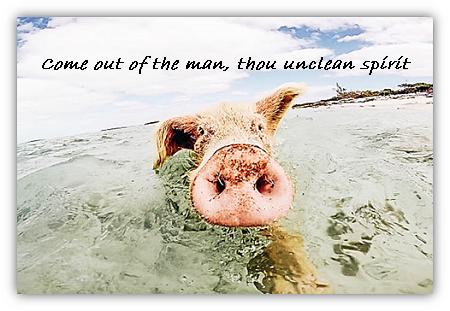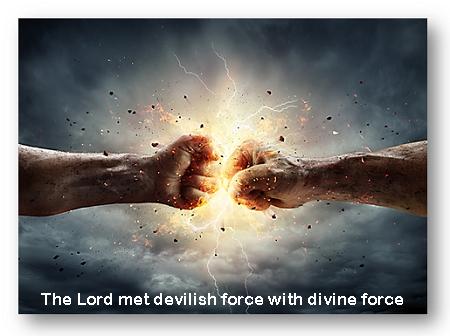Mark 5:1-20 - The Healing of the Gadarene Demoniac
Mark 5:1-20 - The Healing of the Gadarene Demoniac
Read Mark 5:1-20

We live in a society that is obsessed with darkness, death, and devils. In October, you can hardly go into stores or down the street without seeing a display of ghosts, goblins, and gravestones. Some might think of it as innocent fun, but as one of my students from Africa once commented, “Why would Americans joke with something that kills thousands of people in my country and keeps hundreds of thousands in bondage and darkness?”
It is also not innocent when books and films focus on vampires, witches, terror, and death. Is this not paving a return to the darkness of paganism, where devils and darkness are welcome, and the teachings of Christianity are no longer tolerated, but resisted? Will this usher in the return of the bondage that reigned for many centuries before the light of the gospel shone widely throughout Western Europe and America? It certainly seems like it.
What will loosen the hold of darkness as it comes creeping up on our own country today? Who can save us from the devil’s influence, which so many seem to be courting today? Is there a force stronger than the devil? Christ’s miracle in Gadara proves that there is One who is not only stronger than the devil, but acts in compassion and mercy to save from the devil’s grip.
A Satanic Reaction⤒🔗
The Lord Jesus and His twelve disciples had just crossed the sea of Galilee. During that crossing, Christ had done a great miracle, calming the raging of the sea, which left the disciples awestruck: “What manner of man is this, that even the wind and the sea obey him?” (Mark 4:41). On the other side, Christ met not the power of one of the forces of creation, but the prince of the power of the air (Eph. 2:2).
Jesus and His disciples came to land in the region of the Gadarenes, which had as its capital the city of Gadara. This was also known as the Decapolis region on the east side of the Jordan and Sea of Galilee. The people here were not Jews, but Gentiles. The region was known for its hog farming, something anathema to the Jews. According to the stipulations of Mosaic law, pigs were unclean. Roman armies would march through the region regularly, pillaging homes and cities and keeping the people in subservient fear.
Even more fearful to these people than these armies, however, was a single man – if you could even call him a man. At one time he seemed to have had normal relationships with others, for after Christ healed him, he would go home to his friends (v. 19). But this man had become so controlled by demons that he must have become unrecognizable to his friends and family. We read later that he was possessed by a legion of demons (v. 9). A Roman legion was comprised of, some say, six thousand foot soldiers and two hundred cavalry. Clearly, this man would have been totally uncontrollable. In fact, when people tried to restrain him with chains, he would snap the chains and continue to rage (v. 4). “Always, night and day, he was in the mountains, and in the tombs, crying, and cutting himself with stones” (v. 5). We read that he even “had his dwelling among the tombs” (v. 3). Luke tells us that he went around without clothes, striking fear into the heart of any traveler who would come within hearing distance.
The devil always works to destroy. If he can hold a man in bondage with less than this, he won’t waste his efforts, but he loves nothing better than to “steal, kill, and destroy” (John 10:10). So Satan, known in the Bible as the prince of the power of the air, brings fear to this whole region (Heb. 2:14).

In our account, another Prince has arrived on the shores of this area. He might as well have come into enemy territory. When Christ landed on the shore, it seems this man saw Him coming from a distance and began to run wildly, full speed down the hill toward Jesus, crying out, “What have I to do with thee, Jesus, thou Son of the most high God?” (v. 7).
What a strange mixture of aggression and reverence. On the one hand, there could not be a greater contrast than between Christ and this man who was full of hostility towards Christ. However, at the same time, the man falls at the feet of Christ, in a prostrate position, doing obeisance to the Lord. Clearly, this cannot be true worship from the heart. James tells us that the devils believe and tremble (2:19); they do what many human beings never think to do – to tremble before the majesty of Christ. Notice also that the demons acknowledged Christ for who He is – the Son of God. Moreover, they spoke about hell as a real place and a place of torment (see v. 7). This Satanic reaction to Christ teaches us that, one day, every knee shall bow (Phil. 2:10-11). How necessary it is to learn to bow now in the day of grace.
The Man’s Restoration←⤒🔗
Turning our attention to the man in our passage, we have to say that he was barely a man at this point. He acted worse than animals, and for all intents and purposes, his life was almost a living hell. This man lived on the brink of the abyss. What mercy when Christ delivers him from such a desperate state!
Notice first of all how the restoration of this man proved Christ’s royal power. He did not need any ceremony or ritual. He did not need battering rams and canons to put down this legion. As the King of kings and Lord of lords, He is more than the six thousand footmen and two hundred horsemen. He simply spoke one command: “Come out of the man, thou unclean spirit” (v. 8).
Some may wonder whether the response of the devils proves that Christ did not have immediate effect. After all, these demons came back at Him and begged not to be sent directly into hell, but instead to enter into the pigs (v. 12). But what Christ did actually proved and displayed the Lord’s power all the more, for if these demons were capable of driving a herd of a couple thousand pigs down a cliff into the sea, they must have been absolutely ferocious inside this man. Thus, Christ’s power is demonstrated to be that great!
Notice, secondly, the restoration of this man shows Christ’s priestly compassion. The fact that He allowed the demons to go into these pigs showed how precious a soul is to the Lord. It is above the value of anything and everything.
Moreover, the Lord Himself mentioned that it was compassion. After all is said and done, we read in verse 19, “Go home to thy friends, and tell them how great things the Lord hath done for thee, and hath had compassion on thee.” It was not only power that set this man free; it was compassion, mercy, divine love. The Lord met devilish force with divine force, but He also met this miserable man with mercy. He pitied him. Truly Christ is our High Priest “who can have compassion … on them that are out of the way” (Heb. 5:2).
The Citizens’ Rejection←⤒🔗
You would expect the citizens of the area who witnessed what Christ did to this man to fall at Christ’s feet in awe and thankfulness. Finally, an uncontrollable legion of devils had been expelled! This man, their old friend and neighbor, had been restored again. With their own eyes, they saw that he was “sitting, clothed, and in his right mind” (v. 15). You might even think that they would have implored the Lord Jesus to have compassion on them as well.
We do read that they were “afraid” (v. 15). They realized something great had happened. They were impressed and in awe, and yet, as so many, they did not submit to Christ. Instead, “(t)hey began to pray him to depart out of their coasts” (v. 17). What a contrast with the restored man, who “prayed him that he might be with him” (v. 19). You can’t imagine two more opposite responses to Christ.

Have you come to need this Christ and His strong compassion? His compassion is strong enough for the worst and most wretched of sinners. He can keep you from going down to this pit, as we read in Job 33:24: “Then is he gracious unto him and saith: Deliver him from going down to the pit: I have found a ransom.”
This compassionate High Priest is Himself the ransom. As the Prince of Life, He descended into hell on the cross in order to do battle with the devil and make a show of him openly (see Col. 2:15). It’s no wonder that the church of the Reformation sings:
And tho’ this world, with devils filled,
Should threaten to undo us,
We will not fear, for God hath willed
His truth to triumph thro’ us;
The prince of Darkness grim,
We tremble not for him;
His rage we can endure,
For lo, his doom is sure,
One little word shall fell him.
Questions←⤒🔗
- Why is our society more and more obsessed with the powers of darkness? What posture do Christians often have? And what does this passage help us see about the reality of the devil, hell, and Christ?
- Christ’s words could do more than the chains that the people used to bind this man. What does this tell us about the power of Christ’s Word still today?
- What can we learn from how these demons approached Christ?
- Think of two or more lessons that Christ taught by allowing the demons to go into the pigs.
- What are some of the more subtle ways we share the attitude of the citizens?
- What comfort is it to know that this Prince of Life is also a compassionate High Priest – and vice-versa?

Add new comment